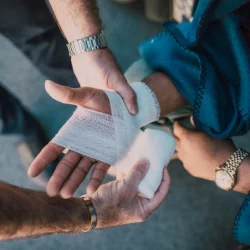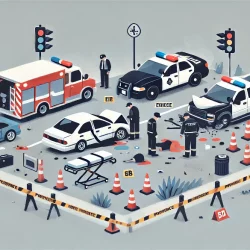Motorcycle and Car Accident. Who's at fault?
Every year, thousands of motorcyclists and car drivers are involved in accidents that result in injuries or even death. When these accidents occur, determining who is at fault can be complex and filled with legal and insurance considerations. Understanding the causes of motorcycle and car accidents, analyzing the legal aspects of fault, and knowing the role of insurance in accident cases are all key factors in determining fault in these situations and preventing them from happening in the future.
Understanding the Causes of Motorcycle and Car Accidents
Motorcycle and car accidents can be devastating, resulting in injuries and even fatalities. It is important to understand the causes of these accidents to prevent them from happening in the future. There are many factors that contribute to accidents involving motorcycles and cars, including common factors, differences in vehicle dynamics and visibility, and road conditions and environmental factors.
Common Factors Contributing to Accidents
Driver error is one of the most common factors that contributes to accidents involving motorcycles and cars. Distracted driving, such as using a cell phone or eating while driving, can take a driver's attention away from the road and increase the risk of an accident. Speeding is another common factor that can lead to accidents, as it reduces a driver's ability to react to sudden changes in traffic conditions. Failure to obey traffic signals and signs, such as running a red light or stop sign, can also contribute to accidents. Driving under the influence of drugs or alcohol is another major cause of motor vehicle accidents, as it impairs a driver's ability to make sound decisions and react quickly to changing conditions.
In addition to driver error, environmental factors can also contribute to accidents. Slippery or wet roads, poor visibility due to weather conditions or time of day, and road debris can all create hazardous conditions for drivers of both cars and motorcycles. Similarly, poor road design and maintenance, such as potholes and uneven surfaces, can create hazards for drivers.
Differences in Vehicle Dynamics and Visibility
Motorcycles and cars operate differently, and these differences can contribute to accidents. Motorcycles are smaller and less visible than cars, and may maneuver differently, making it more difficult for car drivers to see them and anticipate their movements. In addition, motorcycles are not as stable as cars and can be more challenging to handle, especially in adverse weather conditions. This can make it more difficult for motorcycle riders to maintain control of their vehicle, and can increase the risk of an accident.
Road Conditions and Environmental Factors
Environmental factors, such as slippery or wet roads, poor visibility due to weather conditions or time of day, and road debris, can also contribute to accidents. Similarly, poor road design and maintenance, such as potholes and uneven surfaces, can create hazards for drivers of both cars and motorcycles. It is important for drivers to be aware of these hazards and to adjust their driving accordingly.
In conclusion, there are many factors that contribute to motorcycle and car accidents, including driver error, environmental factors, and differences in vehicle dynamics and visibility. By understanding these factors and taking steps to prevent them, we can help to reduce the number of accidents on our roads and keep ourselves and others safe.
Analyzing the Legal Aspects of Fault
Motorcycle and car accidents can be devastating, and determining legal fault is critical in the aftermath of an accident. Several factors come into play when analyzing legal fault, including comparative negligence and shared fault, traffic laws and regulations, and the importance of gathering evidence to prove fault or refute allegations of fault.
Comparative negligence is a legal concept that plays a significant role in determining fault in an accident. It allows a court or insurance company to divide fault between multiple parties involved in an accident. Shared fault is a similar concept that assigns a portion of the responsibility for an accident to each driver involved. These concepts can impact the outcome of a legal case or insurance claim and can affect the damages that a driver or their insurance company may be responsible for paying.
When analyzing fault, it's essential to consider traffic laws and regulations. Drivers of both cars and motorcycles are required to obey traffic laws and regulations, such as speed limits, stop signs, and traffic signals. Violations of these laws can result in citations and fines, as well as contribute to accidents. Knowledge of traffic laws and regulations is critical for drivers to avoid accidents and prevent legal issues that can arise in the event of an accident.
Gathering evidence is critical in establishing fault in a motorcycle or car accident. This evidence can include police reports, witness testimony, and photographs or videos of the accident scene. Additionally, evidence of vehicle damage, injuries, and medical bills can all be used to support a driver’s claim of fault or refute allegations of fault made against them.
It's important to note that proving fault can be a complex and challenging process. In some cases, it may be necessary to hire an experienced attorney to navigate the legal system and ensure that your rights are protected. An attorney can help you gather evidence, negotiate with insurance companies, and represent you in court if necessary.
Overall, understanding the legal aspects of fault in a motorcycle or car accident is critical. By knowing the factors that come into play, drivers can take steps to avoid accidents, protect their rights, and ensure that they are not unfairly held responsible for an accident. Further, it is highly recommended to contact an auto accident attorney or a personal injury attorney after an accident. An experienced motorcycle accident attorney is recommended for bikers.
The Role of Insurance in Accident Cases
Insurance coverage is a critical factor in determining fault and damages in motorcycle and car accidents. In addition to providing financial protection, insurance coverage can also provide peace of mind for drivers and their families.
When drivers purchase insurance policies, they are essentially transferring the risk of financial loss due to an accident to the insurance company. Insurance companies use complex algorithms and actuarial tables to calculate the risk of an accident occurring and the potential cost of damages. This information is used to determine the cost of insurance premiums.
Insurance Coverage for Motorcyclists and Car Drivers
Motorcycle and auto insurance policies vary in terms of the types and amount of coverage provided. Liability coverage, collision coverage, and comprehensive coverage are some of the common types of coverage available. Liability coverage typically covers damages and injuries sustained by other drivers and passengers in an accident that the policyholder is found to be at fault for. Collision coverage covers damages to the policyholder's vehicle in the event of a collision, regardless of who is at fault. Comprehensive coverage covers damages to the policyholder's vehicle that are not the result of a collision, such as theft or weather-related damage.
It is important for drivers to understand what their policies cover and how much coverage they have for different types of accidents. For example, a driver who frequently drives in areas with high rates of uninsured motorists may want to consider purchasing additional uninsured motorist coverage.
How Insurance Companies Determine Fault
Insurance companies use a variety of factors to determine fault in a motorcycle or car accident. In addition to the driver's statements, police reports, witness testimony, and physical evidence, insurance companies also consider whether traffic laws and regulations were followed and the severity of the accident when determining fault.
In some cases, fault may be shared between multiple drivers. For example, if one driver was speeding and ran a red light, but another driver was distracted and didn't see the first driver, both drivers may be found to be partially at fault for the accident.
Settling Claims and Disputes
Settling claims and disputes related to motorcycle and car accidents can be a complex process. Insurance companies may offer settlements that are less than what a driver or their insurance company feels is fair. In these cases, drivers may need to pursue legal action to receive the compensation they deserve.
It is important for drivers to document the details of the accident, including taking photos and obtaining contact information for any witnesses. Drivers should also keep detailed records of any medical treatment or vehicle repairs related to the accident.
In addition to insurance claims, drivers may also be able to pursue legal action against other parties involved in the accident, such as the manufacturer of a defective vehicle part or a government agency responsible for maintaining unsafe road conditions.
Overall, understanding the role of insurance in accident cases can help drivers make informed decisions about their coverage and protect their financial well-being in the event of an accident.
Preventing Motorcycle and Car Accidents
The best way to avoid being involved in a motorcycle or car accident is to practice safe driving habits, maintain vehicles properly, and promote awareness and sharing the road with others.
Safe Driving Practices for Both Motorcyclists and Car Drivers
Safe driving practices, such as avoiding distractions, obeying traffic laws and signs, and avoiding aggressive driving behaviors, can all help prevent accidents. Drivers should also be aware of weather and road conditions and adjust their behavior accordingly. Wearing appropriate safety gear, such as helmets for motorcyclists, is also key to preventing injuries in an accident.
The Importance of Proper Vehicle Maintenance
Maintaining vehicles properly, including regular inspections and repairs, can help prevent accidents caused by mechanical failures. Drivers should also make sure that their vehicles have appropriate safety features, such as functioning headlights and brake lights.
Promoting Awareness and Sharing the Road
Sharing the road with others is critical for preventing accidents involving motorcycles and cars. Motorcyclists and car drivers should be aware of each other and avoid behaviors that could lead to accidents, such as sudden lane changes or failing to signal turns.
In conclusion, motorcycle and car accidents are complex legal and insurance matters that require careful consideration of many different factors. Understanding the causes of accidents, analyzing fault and navigating the insurance process, and taking steps to prevent accidents are all important for drivers to stay safe and avoid the consequences of accidents.
More to Read:
Previous Posts:




